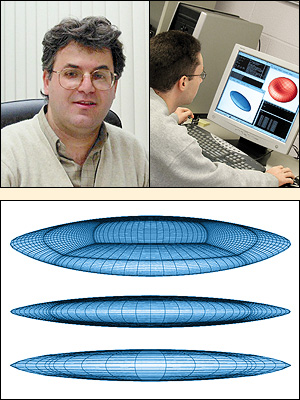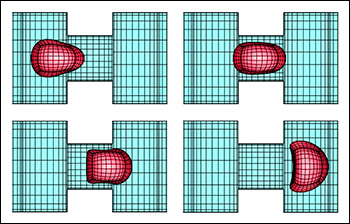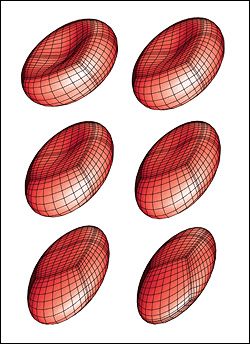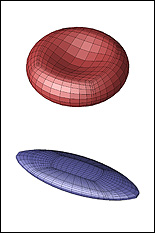News Story
Dimitrakopoulos' Capsule Dynamics Research Featured in Physical Review Letters

Above: Professor Panos Dimitrakopoulos (left) and his graduate student Walter Dodson (right) investigate the dynamics of artificial capsules and erythrocytes in flow enviroments. Below: Capsules in strong extensional flows develop steady-state shapes whose edges form spindled (or concave) become cusped with increasing flow rate so that they are able to withstand the increased hydrodynamic forces.
A research study conducted by Department of Chemical and Biomolecular Engineering associate professor Panos Dimitrakopoulos and his graduate student Walter Dodson that describes the behavior and deformation of capsules in high flow-rate environments has been published in Physical Review Letters, one of the world's top physics journals. The paper, titled "Spindles, Cusps, and Bifurcation for Capsules in Stokes Flow," presents the results of a computational investigation using a highly accurate numerical algorithm developed in Dimitrakopoulos' Biofluid Dynamics Laboratory.
Capsules (membrane-enclosed fluid volumes) are commonly used in a variety of industrial and biomedical applications that require the controlled release of pharmaceuticals, aromas, flavors or other agents. As the capsules travel through flow environments, they deform significantly in response and may rupture in strong enough flow rates. Avoiding the premature rupture or degradation of the agent-carrying capsules, which are subject to strong fluid flows in manufacturing or in the body, is an important part of maintaining safe, effective, and high-quality products. However, due to the complex interaction of fluid dynamics with membrane tensions, little is currently known about capsules' deformation and dynamics in strong flows despite their wide use. In order to accurately understand and describe the capsules' behavior under various flow conditions, Dimitrakopoulos and Dodson used an advanced spectrally-accurate computational algorithm that they recently developed under a National Science Foundation grant. (See related story »)
The resulting study shows that strain-hardening capsules in strong extensional flows develop steady-state shapes whose edges form spindled (or concave) become cusped with increasing flow rate so that the capsules withstand the increased hydrodynamic forces. These findings complement the similar evolution for low-viscosity drops first identified by the famous experiments of G.I. Taylor in 1934, the results of which were further explained in the 1970s and 1980s and are still used in many applications today. The findings also show that capsule dynamics are more complicated than previously thought. The spindled-to-cusped edge transition results from the appearance of compressive tensions near the capsule's edges at high flow rates. By implementing different transient experiments, Dimitrakopoulos and Dodson also found that the highly non-linear nature of capsule dynamics results in a bifurcation in the steady-state shapes (existence of both spindled and cusped edges for a range of high flow rates), as a result of the different evolution of the membrane tensions.
"Our work provides physical insight on the extensional dynamics of capsules in strong flows or large deformations," Dimitrakopoulos explains, "while our results can be used to predict not only membrane rupture, but also the location of the rupture for a specific membrane with a known lytic tension [the maximum value of tension a membrane can withstand before rupturing]. Our study clearly demonstrates the importance of compressive tensions in capsule mechanical deformation that is applicable to both industrial and physiological processes. We hope it provides motivation for more experiments with capsules at high flow rates, especially experimental studies that could monitor the capsule from different viewing angles in order to capture the details of the complicated three-dimensional interfacial shapes we found."
Related Story: "Dimitrakopoulos Wins 2 NSF Grants" »
View the Abstract or Read the Article: Spindles, Cusps, and Bifurcation for Capsules in Stokes Flow »
Published November 26, 2008

















